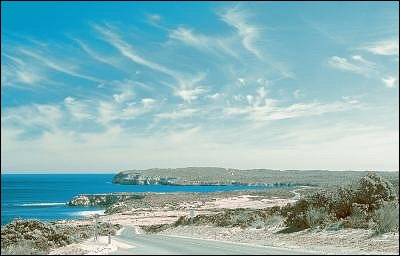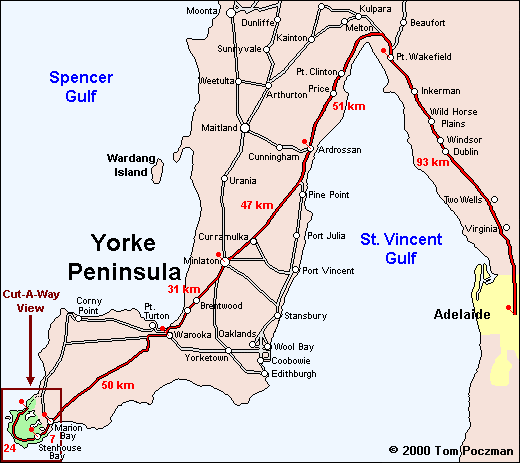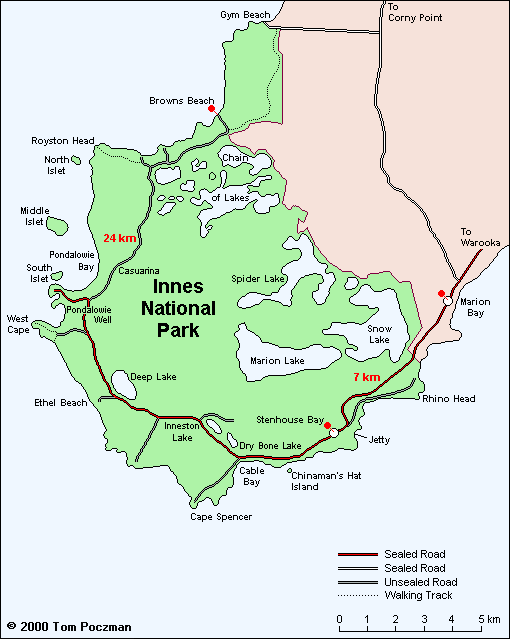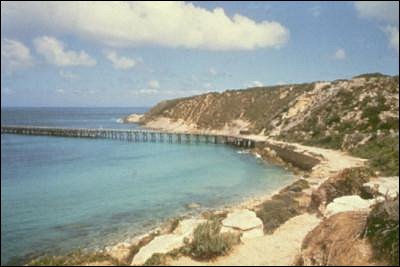Browns Beach
Introduction
 During the winter months, Browns Beach is a Mecca for surf fishing enthusiasts, and after a recent trip (Feb 19th, 2000) there to simply quench my thirst in getting my beach rods wet, I found that a LOT of work by the SA National Parks & Wildlife had been done to the area, in the form of upgraded roads, nature-walk paths, designated camp sites, and towards the protection of native flora and fauna. During the winter months, Browns Beach is a Mecca for surf fishing enthusiasts, and after a recent trip (Feb 19th, 2000) there to simply quench my thirst in getting my beach rods wet, I found that a LOT of work by the SA National Parks & Wildlife had been done to the area, in the form of upgraded roads, nature-walk paths, designated camp sites, and towards the protection of native flora and fauna.
 Historically, Browns Beach had been one of those places where it was great to be there, but a damned hell in getting there. The road surface conditions from Stenhouse Bay were unsealed and frequently corrugated and grading them was inversely infrequent. Toilet facilities were nonexistent, and your basic camping ground was an indiscriminate patch of land in the scrub. Now a days, the road is bitumised up to Pondalowie Bay Camp Grounds, while the unsealed segment to Browns Beach is in excellent condition. Native vegetation has been fenced off with good quality, long term strand fencing, and paths have been erected for nature walk enthusiasts. Historically, Browns Beach had been one of those places where it was great to be there, but a damned hell in getting there. The road surface conditions from Stenhouse Bay were unsealed and frequently corrugated and grading them was inversely infrequent. Toilet facilities were nonexistent, and your basic camping ground was an indiscriminate patch of land in the scrub. Now a days, the road is bitumised up to Pondalowie Bay Camp Grounds, while the unsealed segment to Browns Beach is in excellent condition. Native vegetation has been fenced off with good quality, long term strand fencing, and paths have been erected for nature walk enthusiasts.
 Designated camp sites have been erected, with the basic provisions of bore water access and toilet facilities with long log drops ! The main and most frequently visited camping ground is at Pondalowie Bay, and also has provisions for a solar powered phone booth in case of emergencies. One point to note is that Optus Mobiles do NOT work at all in the bottom end of Yorke Peninsula. I am not sure how Telstra services fair in the same area. Designated camp sites have been erected, with the basic provisions of bore water access and toilet facilities with long log drops ! The main and most frequently visited camping ground is at Pondalowie Bay, and also has provisions for a solar powered phone booth in case of emergencies. One point to note is that Optus Mobiles do NOT work at all in the bottom end of Yorke Peninsula. I am not sure how Telstra services fair in the same area.
Browns Beach is part of the Innes National Park. The park itself has an area over 100 square kilometres of natural mallee bushland which provides an attractive backdrop to the scenic coastal views. It represents one of only a few pockets of significant vegetation on the peninsula. The bushland is home to an abundance of native flora and fauna, and there are a number of clearly defined and marked walking trails throughout the park. Innes was declared a National Park in 1970 after the discovery of the very rare and shy Great Western Whipbird in 1965.

The park was named in recognition of William Innes, who discovered commercial quantities of gypsum in the 1890s. In 1913, Mr Innes set up the works site of Inneston. A jetty was built at Stenhouse Bay to enable ships to berth and load the bagged gypsum. The Inneston Historic Site is well worth a visit. Some time ago, my family and I visited this site and we came across a huge concrete slab. After much deliberation in trying to determine its function or purpose, we deduced that it had been infact a tennis court. To our amazement, the pioneers used a simple concept in defining the court line markings for this slab - perfectly straight and linear control joints, and with absolutely no cracks or degradation in the surface over its life. When considering that the area possessed huge amounts of gypsum, which is in itself the best catalyst for stabilizing soils and breaking clay down, you would not expect any movement what so ever in this improvised tennis court.
Onward Bound
Irrespective of the duration of any fishing trip, I personally find its preparation as exciting as the event of fishing itself. Whether the trip be for one night or one week, I diligently go through all my equipment, ensure I have enough pre made rigs, determine the type and number of sinkers and lures I may need, guestimate times and duration of travel so as to adhere to a predetermined schedule. The simple notion of travelling to Browns for a fishing stint conjures up images of playing with and catching Australian Salmon.
The map below shows the quickest way as well as those major towns one would encounter while travelling to Browns Beach from Adelaide. The Pt. Wakefield Highway has been for some time now a main dual lane road, and provides a safe if not a speedy egress out of Adelaide.

The Towns
One of the first main towns towards Browns Beach is Port Wakefield. Port Wakefield was the first government town north of Adelaide. The town takes its name from the River Wakefield, which was discovered by William Hill in 1838, who named it after Edward Gibbon Wakefield. Prior to 1850 the port was known as Port Henry. The port was first established to ship copper from the rich mines of the Burra area. Vessels of the largest tonnage were discharged within three miles of the township with safety by means of barges. By 1857 the copper trade ceased when a rail terminal was established at Gawler. The port later served as the main outlet for wheat and wool for the district around it.
Today, the town is well known to the travelling public, with many roadhouses along this strip providing valuable refreshment facilities for most road travellers.
The next major town is Ardrossan. Situated on the east coast of Yorke Peninsula, Ardrossan is the largest eastern port with extensive facilities for the mining and shipping of dolomite as well as being the third largest grain bulk handling facility in the state, boasting a 70 metre elevator tower, the largest of its type in South Australia. The locality was first known by the European settlers as Clay Gully' or `Parara'. The town was named by Governor Fergusson after `Ardrossan', the town in Ayrshire, Scotland and was proclaimed in 1873.
Ardrossan is famous for its Blue Crabs, which can be caught using nets from the jetty, or by dabbing at low tide. Excellent views of St Vincent Gulf are observed from the BHP quarry lookout, together with an opportunity to see the dolomite mining operation in action. The "Zanoni" shipwreck is situated approximately ten nautical miles south east of Ardrossan, and is acknowledged as one of the most interesting wrecks in South Australian waters for diving groups.
Next on the list, Minlaton, which is a combination of the Aboriginal word 'minla', meaning `sweet' and the Middle English 'ton' meaning 'town'. The land was first taken up in 1847 by Mr. T. Giles and the town was surveyed in 1876. Minlaton today is the commercial centre for the surrounding rich barley, wheat and grazing districts.

The history of Warooka, which derives its name from the Aboriginal word, 'wiruka', meaning 'muddy water hole' dates back to the early 1847, when James Coutts took up a run of 120 square miles extending from Hardwicke Bay south to Sturt Bay. Settlers began moving into the Warooka Hill area at the end of 1870. James Angas Johnson (a grandson of George Fife Angas, one of South Australia's first promoters) was an early selector and, with Edward Jacobs wanting to open a store at the cross roads, laid out the first lots of Warooka in 1876.
Warooka established a reputation for high quality malting barley. It's prosperity has been based on barley, and the cure of a manganese deficiency in the light calcareous soils in 1925 by fertiliser mixtures and later by crop spraying, has ensured increased production for the district. Warooka is the last large town through which the main stream of traffic passes before venturing to the sparsely populated 'bottom end' of the Yorke Peninsula.
Marion Bay was named after a sailing ship which was wrecked south of the Troubridge Shoal in 1851. Originally a gypsum port, it is now home to a small crayfishing fleet. Located at the entrance to Innes National Park, Marion Bay is a very popular accommodation base for park visitors. It has a safe, sheltered family beach on one side, a surf beach on the other.
Stenhouse Bay, situated within the confines of the Innes National Park, the area was for many years the chief source of gypsum for Australia's plaster industry. It now offers an excellent if not last stop for refreshments, beer, petrol, tackle, firewood and fuel.

The time taken to travel from Adelaide GPO to Browns Beach is about 3.5 hrs. A breakdown of distances traversed are as follow
| Destination | Distance Travelled (km) |
| Adelaide GPO - Pt. Wakefield | 93 |
| Pt. Wakefield - Ardrossan | 51 |
| Ardrossan - Minlaton | 47 |
| Minlaton - Warooka | 31 |
| Warooka - Marion Bay | 50 |
| Marion Bay - Stenhouse Bay | 7 |
| Stenhouse Bay - Browns Beach | 24 |
| Total | 303 |
Conclusion
Considering that winter will be upon us soon, what better way is there in spending it than by the beach, fishing ! Personally, I have had many failures, as well as successes fishing at Browns. In my younger days, more time was spent making sure Coho, Chinook and I had enough beer to drink while fishing than bait, especially when Coho uses all the bait and Chinook drinks all the beer !! Either way, Browns Beach always offered us the degree of excitement one expects when fishing for Australian Salmon.
A tip I came across from my last visit to Browns - rather than using tripple 4/0 snelled ganged hooks and a whole pilchard, just try one hook thru the bottom half of a pilchard with a half hitch around the tail. This type of bait presentation was more successfull than a whole pilchard rig. It also saves on bait.
You may also want to read up on some other articles I have written about Browns Beach and Australian Salmon.

 Fishing Tip : Fishing Tip : |
|
| Why not contact fishSA.com about your Fishing Tip |
|
|